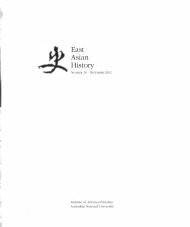Portrait of a Tokugawa Outcaste Community ... - East Asian History
Portrait of a Tokugawa Outcaste Community ... - East Asian History
Portrait of a Tokugawa Outcaste Community ... - East Asian History
You also want an ePaper? Increase the reach of your titles
YUMPU automatically turns print PDFs into web optimized ePapers that Google loves.
104TIMOTHY D. AMOS59 Ibid., 72 [135]60 Based on my analysis <strong>of</strong> documents authoredby local eta leaders in eastern Japan,it does not appear as if the word heinin wasused by these communities themselves.61 For a technical discussion <strong>of</strong> the differencesbetween these two kinds <strong>of</strong> documents inrelation to status consult Sata Shin'ichi, Shinpankomonjogaku nyu. mon (Tokyo: Haseidaigaku shuppankyoku, 1997), pp.162-63.62 SDKK, ed., Suzuki-ke monjo, Yol.1, 111[1127].community. In 1855, a striking law warning members <strong>of</strong> the eta communitynot to comport themselves in ways that caught the attention <strong>of</strong> commonersand led to the neglect <strong>of</strong> workplace duties (shiroto no kiuke ni nazumibayaku wo naozari mata wa mibun wo kazari hyakusho-ke ni tachiiri *AZ'::'1ft!.t 1 7l*lx11t7t7 fr!isj&*'::':lr.AJ was issued. 59It is important to record here, though, that the term shiroto is usedinstead <strong>of</strong> heinin. This suggests a way in which the meanings <strong>of</strong> thesetwo terms differed in the eighteenth and nineteenth cent uries, and thatthe discourse <strong>of</strong> commoner (almost exclusively written as heinin), like thelabel eta, may not have been adopted within Lower Wana village itself. 6 0One may speculate that heinin was, rather, a term used by the shogunate,by domain authorities, and by Danzaemon himself during the eighteenthcentury to define the precarious lives <strong>of</strong> different people under the onelabel "outcaste" (eta-hinin-nado). It was an <strong>of</strong>ficial discourse used as amechanism to enable stable rule and unify punitive powers. But local etaand hinin communities themselves did not internalize it. The "other" foreta and hinin was not a heinin }jZ A but a sh iro to: a word that wouldappear to connote a lack <strong>of</strong> expertise in agriculture rather than an absence<strong>of</strong> normality. This is not to say, however, that a "commoner-outcaste"discourse had no impact on the village. Although members <strong>of</strong> LowerWana village did not overtly appear to internalize a "commoner-outcaste"polarization, considerable attempts at self-definition were made by theSuzuki family head from around the 1770s. While adoption <strong>of</strong> the <strong>of</strong>ficialterminology was rejected, the idea that eta and hinin were in some waydifferent from the rest <strong>of</strong> the community and therefore a phenomenon thatdemanded historical explanation appears to have been accepted.Eta-hinin relations too may be seen as becoming increasingly influencedby an "outcaste-commoner" binary distinction during this period.Hinin, it may be argued, were also increasingly treated as a kind <strong>of</strong> outcastewithin Lower Wana village. From around the middle <strong>of</strong> the eighteenthcentury, for example, oaths <strong>of</strong> obedience addressed from the hininhut leader Kakube to Jin'emon were written on tategami *iiEf$; paper (asopposed to the oaths <strong>of</strong> obedience from eta villagers to Jinemon, whichwhere written on yokogami :tJhe; paper), indicating a clear differencein perceived status. 61 Kakube was, moreover, consistently the last namelisted on <strong>of</strong>ficial documentation that needed to be signed by the entirevillage from around this time. But perhaps the most blatant example <strong>of</strong>the appropriation <strong>of</strong> the binary logic <strong>of</strong> "commoner-outcaste" within theLower Wana village community can be glimpsed in a document presumablydated in the 1850s where Jin'emon listed his place <strong>of</strong> residence as"Wana village" and Kakube's as "Lower Wana village. , ,62 Moreover, in adispute between the residents <strong>of</strong> Upper and Lower Wana village over landownership and management only a few years later, a resident <strong>of</strong> UpperWana village planted ushigoroshi 4 or "butcher trees" (Pourthiaea Villosa)in three places along the boundary between his land and Kakube's
















